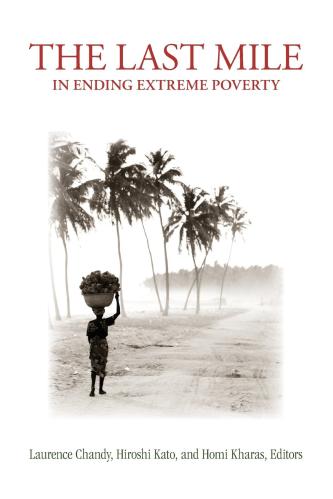Recent studies by Thomas Piketty and others have told us a lot more about income among the richest 1 percent in America. But doing the same for America’s poorest is a much murkier proposition. Laurence Chandy and Cory Smith weigh in on five key questions raised by their latest research. For a more detailed look at $2 poverty in the United States, read the latest paper by Chandy and Smith.
What percentage of Americans live on under $2 a day?
This question was posed in an important study of U.S. poverty last year by Luke Shaefer and Kathryn Edin. The authors found that millions of Americans live on less than $2 a day.
This finding is striking. The $2 threshold has traditionally been used to measure poverty in the developing world and is far below the official U.S. poverty line, which is equivalent to around $16 per person per day.
In a new study, we reexamine this question from multiple vantage points. We obtain estimates of the $2 a day poverty rate in the U.S. for 2011/12 that range from 4 percent (12 million people) to zero depending on the definition of resources and the data source used (Figure 1). Obtaining a definitive estimate of $2 a day poverty would require an uncontested definition of poverty and a data source with no flaws—neither of which we have. While the estimates we obtain vary, the fact that even some have millions of Americans living under $2 a day is alarming.
Figure 1: Different estimates of $2 a day poverty rate

What does the range of estimates tell us?
First, a significant portion of $2 poverty appears to be temporary, as evidenced by the lower poverty rates recorded when we extend the duration over which individuals’ welfare is assessed. Such spells may be accounted for by life events such as moving between jobs that are not necessarily indications of diminished welfare. Second, social protection programs play a critical role in the welfare of many of America’s poorest households. Programs such as food stamps (SNAP) and the Earned Income Tax Credit mean the difference between living above the $2 threshold or below it for millions of people according to some estimates. Third, a significant share of consumption for the $2 poor likely occurs out of resources that don’t count as income: savings and assets, borrowing, and in-kind government assistance. Poverty estimates based on income (money earned) and consumption (money spent) differ widely. This discrepancy is in keeping with the higher variability of income from month to month.
If by some measures millions of Americans live on under $2 a day, doesn’t that make their condition equivalent to the poor in the developing world?
Not so fast. If we used the exact same criteria to measure poverty in the U.S. as is used by the World Bank to obtain official poverty estimates for the developing world, we would conclude that no-one in the U.S. falls under the $2 threshold. Part of the reason for this is that even the poorest people surveyed in America appear to find a way to meet their most basic material needs (valued above $2 a day) even if their reported income is zero or close to zero. Furthermore, the poor in America have access to public goods—public education, criminal justice and infrastructure—that would be the envy of the poor in the developing world.
However, poverty is manifested in different ways in the U.S. and developing countries. Focusing narrowly on material needs means missing other critical components of welfare that may be especially lacking among America’s poorest people. For instance, those whose survival depends on in-kind assistance may be assured that their most basic material needs are met, but the absence of a reliable source of income makes it extremely difficult to cope with the unexpected, such as replacing broken or stolen assets or emergency travel. These individuals face a virtual exclusion from the cash economy implying a dearth of agency that directly affects their welfare.
If comparisons of poverty in the U.S. and the developing world are so complicated, are they worth the bother?
Two developments over the past 12 months would suggest they are—or at least that they deserve further exploration.
First, a new global effort is underway to end extreme poverty (defined using the $1.25 poverty line) around the world by 2030. This will be the overarching objective of a set of Sustainable Development Goals which will guide the efforts of the global development community in tackling collective action problems over the next generation. While it is unclear precisely how this framework will develop, it will raise the demand for approaches to poverty measurement that can be meaningfully applied across different settings. On this issue, it is notable that while the official $2 a day global poverty rate has been cut by a third since 1996, by at least one measure, $2 poverty in the U.S. has incurred a sharp increase over the same period, albeit from a low base.
Second, the methodology by which the World Bank compiles official global poverty estimates has recently changed. Whereas in the past the estimate was in practice just a measure of poverty in the developing world, the new method incorporates the populations of rich countries. For now, the entire population of these countries is assumed to not be poor. However going forward the assumption that extreme poverty does not exist in the developed world is likely to face greater scrutiny.
How can estimates of the welfare of America’s poorest people be improved?
Obtaining a robust understanding of the extremes—or tails—of the income distribution is notoriously difficult. Due to the pioneering work of Thomas Piketty and others, information about the upper tail of the distribution in rich countries has been greatly advanced in recent years through analysis of tax data. This leaves the lower tail as the least explored and understood part of the distribution in rich countries.
There is a sad irony in the fact that the analytical tools used to assess welfare in the U.S. are poorly equipped to capture those whose lives are most precarious. However, adapting existing surveys to more accurately identify and assess living standards of the poorest members of society is possible. Steps could include oversampling those on very low incomes, addressing low response rates, and incorporating the homeless and institutionalized who are traditionally excluded from survey respondents. Such changes would provide a stronger evidence base to inform poverty programs.
If we accept a shared concern for the poor in society, then it follows by an unstoppable logic that we have an even greater responsibility for the very poorest. Without reliable estimates of their welfare, this responsibility is too easily ignored.
The Brookings Institution is committed to quality, independence, and impact.
We are supported by a diverse array of funders. In line with our values and policies, each Brookings publication represents the sole views of its author(s).







Commentary
U.S. $2 a Day Poverty in a Global Context: Five Questions Answered
August 26, 2014